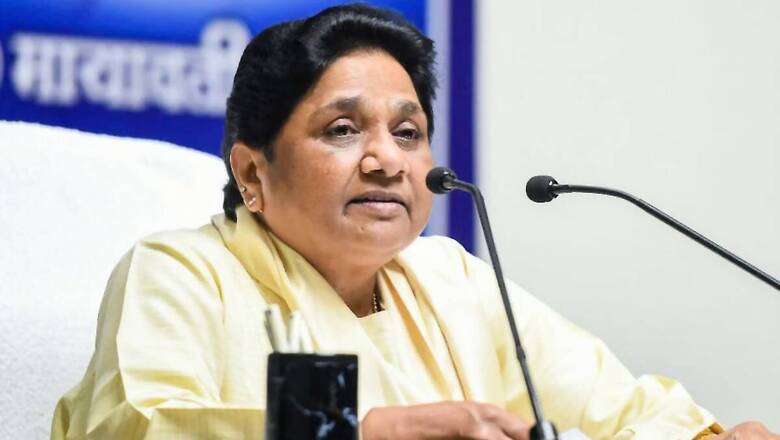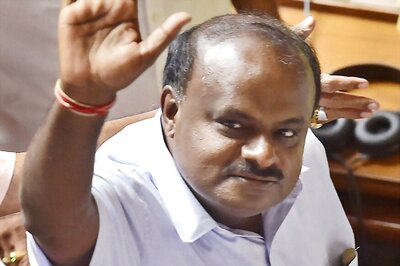
views
Eight months before Uttar Pradesh goes to polls, a critical aspect that defines and determines its political trajectory seems unsettled. It’s crunch time for Dalit politics in Uttar Pradesh that was a crucible for the rise and empowerment of the Scheduled Castes, shepherded by the Bahujan Samaj Party (BSP), its late founder Kanshi Ram, and his protégé Mayawati who became the state’s first Dalit chief minister with an absolute majority in the legislature. Mayawati is rarely seen or heard except on Twitter and the BSP’s once-indomitable organisation is virtually “dysfunctional”, admitted insiders.
Anecdotal evidence suggests that the BSP president is unable to make up her mind on whether she wants to become an appendage of the BJP or reclaim the Opposition turf. Mayawati’s manifest preoccupation is to hand over her legacy and her party to Akash Anand, her young London-returned nephew who was anointed as the “heir”, and her brother, Anand Kumar, who was re-appointed as the BSP’s national vice-president. That makes the BSP one more dynast-helmed entity for the BJP to add to the line-up of “vanshvaad rajniti” in the heartland state.
UP’s parties are palpably thrilled to see the Dalit space opening up before the 2022 elections. But while the BSP has behind it decades of hard ground work, a committed cadre and an ideology that was unfortunately undermined by the leadership’s propensity to strike compromises for short-term benefits, the credentials of the other parties wanting to project themselves as “pro-Dalit” are also questionable.
Samajwadi Party’s Overtures
The Samajwadi Party (SP), that fancies itself as the BJP’s sole alternative, recently ventured into the Dalit terrain. In April this year, when Bhimrao Ambedkar’s 130th birth anniversary was commemorated, Akhilesh Yadav, the SP president, christened the occasion as “Dalit Diwali”. The phraseology was curious and reflected the SP’s unfamiliarity with the Dalit political consciousness. To the politicised Dalits, a festival like Diwali is quintessentially associated with caste Hindu beliefs and, therefore, a superimposition on their religious sensibility that is largely shaped by the minor characters of the Ramayana and Mahabharata such as Shambuka and Eklavya, and the less-celebrated warriors of history like Uda Devi and Jhalkaribai. It is a matter of speculation if Ambedkar, who embraced Buddhism Navayana or neo-Buddhism, would have set store by Diwali celebrations. The only material offshoot of Akhilesh’s gesture was the creation of a Baba Saheb Vahini, a forum to raise Dalit-related matters.
Nevertheless, the Vahini was a big step in the SP’s evolution. Dalits hardly figured in its political schema because its leaders sought out the backward castes, specifically the Yadavs, and the Muslims to construct a core base, which was sometimes replenished by the upper castes. The problem with the SP’s Dalit overture is that it is unlikely to take off for social reasons. While the upper castes have designed ways of co-existing with even the empowered Dalits, the Yadavs are unable to brook the rise of the Dalits and perceive them as competitors in the caste hierarchy. On the two occasions that the SP and BSP struck an alliance, the ostensible camaraderie at the top never percolated down to the ground.
On the other hand, the BJP has had greater success at wooing and co-opting Dalits, particularly Dalit sub-castes such as the Khatik and Valmiki, who are placed lower down the socio-economic ladder, below the Jatav. The Jatavs, the sub-caste to which Mayawati belongs, are the greatest beneficiaries of the statutory quota in education and jobs and, over time, have become a pillar holding up the UP bureaucracy with the Brahmins and Kayasthas.
Alliances in the Works
Sudha Pai, political scientist, author and former JNU professor, classified the recent political history of UP’s Dalits in three phases: the 1990s that saw the evolution of political consciousness and strong social movements among the backward classes (BCs) and Dalits leading to the dominance of the so-called lower caste parties, the SP and BSP, and identity politics; the 2000s which, she contends, witnessed the “weakening” of identity politics that ran parallel to the revival and strengthening of the BJP and a shift among large sections of the Dalits from the “desire for social justice to aspiration”; and lastly, a growing disillusionment with the BJP which erupted in angry street protests the country over that often assumed a violent character. In an article, ‘Changing Political Preferences among Dalits in Uttar Pradesh in the 2000s: Shift from Social Justice to Aspiration’ (Journal of Social Inclusion Studies, 2019), Pai noted, “These rapid shifts point towards internal fragmentation among Dalits; a basic divide between the Ambedkarite and Hindutvawadi Dalits.”
In UP, this trend externalised into violent confrontations between Dalits and Rajputs in western UP, shortly after Yogi Adityanath, a Rajput, was sworn in as the chief minister in 2017. The objective circumstances paved the way for the emergence of a young Dalit leader, Chandrashekhar Azad Ravan from Saharanpur, who helmed the radical Bhim Army. An elusive Scarlet Pimpernel-like character, Azad, a lawyer, was in and out of prison and often eluded the police seeking his arrest. The changing equations in Dalit politics led to the unexpected defeat of the BJP in the bypolls to the Lok Sabha in Gorakhpur, Phulpur and Kairana between March and May 2018. In west UP’s Kairana, the Bhim Army’s support for the candidate jointly fielded by the SP, BSP and the Rashtriya Lok Dal showed cross-currents in the undertow of Dalit politics: Azad complemented the BSP, the BSP shifted its votes to the SP, and the historical Dalit-BC and Dalit-Jat antagonism did not work in that election.
So does Azad have the potential to challenge the BSP? He has ambitions to do so because he re-launched his outfit afresh as the Azad Samaj Party on March 15 last year, Kanshi Ram’s birth anniversary, and established organisations in every district of Meerut and Saharanpur that confines him to the western region. Azad indicated he was in talks with Om Prakash Rajbhar’s Bharatiya Suheldev Samaj Party, rooted in east UP, as well as the SP and the RLD.
It’s too early to assess the likely impact of the fledgling party. Doubtless, the BSP doesn’t always play by the rules of conventional politics. It’s not known for street fights and staging protests. But unless Mayawati comes out of the confines of her bungalows in Lucknow and Delhi, crafts a strategy to broadbase the BSP as she did before her spectacular showing in 2007, and most importantly projects herself as a serious challenger to the BJP instead of equivocating, the future of Dalit politics in UP doesn’t appear promising.
Read all the Latest News, Breaking News and Coronavirus News here.



















Comments
0 comment